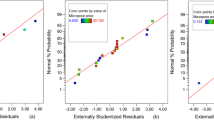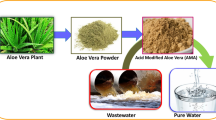Abstract
Humic acid (HA) was impregnated onto powdered activated carbon to improve its Cu(II) adsorption capability. The optimum pH value for Cu(II) removal was 6. The maximum adsorption capacity of HAimpregnated activated carbon was up to 5.98 mg·g−1, which is five times the capacity of virgin activated carbon. The adsorption processes were rapid and accompanied by changes in pH. In using a linear method, it was determined that the equilibrium experimental data were better represented by the Langmuir isotherm than by the Freundlich isotherm. Surface charges and surface functional groups were studied through zeta potential and FTIR measurements to explain the mechanism behind the humicacid modification that enhanced the Cu(II) adsorption capacity of activated carbon.
Similar content being viewed by others
References
Nriagu J O, Pacyna J M. Quantitative assessment of worldwide contamination of air, water and soils by trace metals. Nature, 1988, 333(6169): 134–139
Lacour S, Bollinger J C, Serpaud B, Chantron P, Arcos R. Removal of heavy metals in industrial wastewaters by ion-exchanger grafted textiles. Analytica Chimica Acta, 2001, 428(1): 121–132
Vaca Mier M, López Callejas R, Gehr R, Jiménez Cisneros B E, Alvarez P J J. Heavy metal removal with Mexican clinoptilolite. Water Research, 2001, 35(2): 373–378
Dean J G, Bosqui F L, Lanouette K H. Heavy metals in/from wastewater. Environmental Science & Technology, 1972, 6(6): 512–518
Atkinson B W, Bux F, Kasan H C. Waste activated sludge remediation of metal-plating effluents. Water SA, 1998, 24(4): 355–359
Park D, Yun Y S, Ahn C K, Park J M. Kinetics of the reduction of hexavalent chromium with the brown seaweed Ecklonia biomass. Chemosphere, 2007, 66(5): 939–946
Aydiner C, Bayramoglu M, Kara S, Keskinler B, Ince O. Nickel removal from waters using surfactant-enhanced hybrid PAC/MF process. I. The influence of system-component variables. Industrial & Engineering Chemistry Research, 2006, 45(11): 3926–3933
Matsuura T. Progress in membrane science and technology for seawater desalination-a review. Desalination, 2001, 134(1–3): 47–54
Üçer A, Uyanik A, Aygun S F. Adsorption of Cu(II), Cd(II), Zn(II), Mn(II) and Fe(III) ions by tannic acid immobilised activated carbon. Separation and Purification Technology, 2006, 47(3): 113–118
Jaramillo J, Gómez-Serrano V, Alvarez P M. Enhanced adsorption of metal ions onto functionalized granular activated carbons prepared from cherry stones. Journal of Hazardous Materials, 2009, 161(2–3): 670–676
Ahn C K, Park D, Woo S H, Park J M. Removal of cationic heavy metal from aqueous solution by activated carbon impregnated with anionic surfactants. Journal of Hazardous Materials, 2009, 164(2–3): 1130–1136
Issabayeva G, Aroua M K, Sulaiman N M N. Removal of lead from aqueous solutions on palm shell activated carbon. Bioresource Technology, 2006, 97(18): 2350–2355
Chen J P, Wu S. Simultaneous adsorption of copper ions and humic acid onto an activated carbon. Journal of Colloid and Interface Science, 2004, 280(2): 334–342
Sparks D L. Environmental Soil Chemistry. San Diego: Academic Press, 1995
Wall N A, Choppin G R. Humic acids coagulation: influence of divalent cations. Applied Geochemistry, 2003, 18(10): 1,573–1,582
Keirsse H, VanHoof F, Janssens J, Buekens A G. Adsorption of humic substances on activated carbon prepared from locally available waste materials. In: Proceedings of the 5th International Conference Chemistry for Protection of the Environment, Leuven, Belgium, 1985
Liu J F, Zhao Z S, Jiang G B. Coating Fe3O4 magnetic nanoparticles with humic acid for high efficient removal of heavy metals in water. Environmental Science & Technology, 2008, 42(18): 6949–6954
Yuan W, Zydney A L. Humic acid fouling during ultrafiltration. Environmental Science & Technology, 2000, 34(23): 5043–5050
Bai R B, Zhang X. Polypyrrole-coated granules for humic acid removal. Journal of Colloid and Interface Science, 2001, 243(1): 52–60
Schmitt D, Saravia F, Frimmel F H, Schuessler W. NOM-facilitated transport of metal ions in aquifers: importance of complexdissociation kinetics and colloid formation. Water Research, 2003, 37(15): 3541–3550
Faur-Brasquet C, Reddad Z, Kadirvelu K, Le Cloirec P. Modeling the adsorption of metal ions (Cu2+, Ni2+, Pb2+) onto ACCs using surface complexation models. Applied Surface Science, 2002, 196 (1–4): 356–365
Wu C H, Lin C F, Ma H W, Hsi T Q. Effect of fulvic acid on the sorption of Cu and Pb onto gamma-Al2O3. Water Research, 2003, 37(4): 743–752
Üçer A, Uyanik A, Cay S, Ozkan Y. Immobilisation of tannic acid onto activated carbon to improve Fe(III) adsorption. Separation and Purification Technology, 2005, 44(1): 11–17
Machida M, Aikawa M, Tatsumoto H. Prediction of simultaneous adsorption of Cu(II) and Pb(II) onto activated carbon by conventional Langmuir type equations. Journal of Hazardous Materials, 2005, 120(1–3): 271–275
Acar F N, Eren Z. Removal of Cu(II) ions by activated poplar sawdust (Samsun clone) from aqueous solutions. Journal of Hazardous Materials, 2006, 137(2): 909–914
Özçimen D, Ersoy-Meriçboyu A. Removal of copper from aqueous solutions by adsorption onto chestnut shell and grapeseed activated carbons. Journal of Hazardous Materials, 2009, 168(2–3): 1118–1125
Rangel-Mendez J R, Streat M. Adsorption of cadmium by activated carbon cloth: influence of surface oxidation and solution pH. Water Research, 2002, 36(5): 1244–1252
Webi T W, Chakravorti R K. Pore and solid diffusion models for fixed bed adsorbers. Am. Inst. Chem. Eng. J., 1974, 20(2): 228–238
Senthilkumaar S, Kalaamani P, Porkodi K, Varadarajan P R, Subburaam C V. Adsorption of dissolved Reactive red dye from aqueous phase onto activated carbon prepared from agricultural waste. Bioresource Technology, 2006, 97(14): 1618–1625
Yen T F. Environmental Chemistry: Chemical Principles for Environmental Processes. New Jersey: Prentice Hall PTR, 1999
Hankins N P, Lu N, Hilal N. Enhanced removal of heavy metal ions bound to humic acid by polyelectrolyte flocculation. Separation and Purification Technology, 2006, 51(1): 48–56
Author information
Authors and Affiliations
Corresponding author
Rights and permissions
About this article
Cite this article
Liu, H., Feng, S., Zhang, N. et al. Removal of Cu(II) ions from aqueous solution by activated carbon impregnated with humic acid. Front. Environ. Sci. Eng. 8, 329–336 (2014). https://doi.org/10.1007/s11783-013-0553-9
Received:
Accepted:
Published:
Issue Date:
DOI: https://doi.org/10.1007/s11783-013-0553-9




